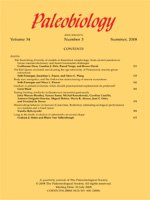Attempts to use Fourier methods to quantify ammonoid suture shape have failed to yield robust, repeatable results because sutures are complex curves that violate the assumptions of Fourier mathematics. In particular, sampled sutures are artificially truncated such that the first and last sampled points are not equivalent, the folds are non-stationary, and a position along a horizontal reference axis may map to multiple amplitudes along the suture path. Here I introduce an alternative Fourier method—the windowed short-time Fourier transform (STFT)—that accommodates these characteristics of complex curves. For each suture, digitized landmarks were parameterized using a tangent angle function and then smoothed by convolving with an apodization function. Piece-wise Fourier transforms were then calculated and averaged, resulting in a robust, unique quantification of line morphology. STFT coefficients and estimated power spectra describing the relative weights of harmonics were generated for 576 Paleozoic-basal Triassic ammonoid genera, representative of the range of suture morphotypes. While insensitive to major episodes of taxonomic turnover (Frasnian/Famennian, end-Devonian, and Permian/Triassic extinctions), the summed power data support the previously observed trend toward increasing suture complexity through time. Moreover, partitioning the summed power statistic into harmonic ranges allows novel insight into Paleozoic suture evolution. In particular, the data show significant shifts in the dominant morphotypes during periods of rebound and radiation and suggest that basal Triassic ammonoids possessed unique suture morphotypes when compared with those of the Paleozoic.
How to translate text using browser tools
1 March 2006
New approaches to Fourier analysis of ammonoid sutures and other complex, open curves
Emily G. Allen
ACCESS THE FULL ARTICLE

Paleobiology
Vol. 32 • No. 2
March 2006
Vol. 32 • No. 2
March 2006




